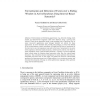Free Online Productivity Tools
i2Speak
i2Symbol
i2OCR
iTex2Img
iWeb2Print
iWeb2Shot
i2Type
iPdf2Split
iPdf2Merge
i2Bopomofo
i2Arabic
i2Style
i2Image
i2PDF
iLatex2Rtf
Sci2ools
127
click to vote
ADBIS
2004
Springer
2004
Springer
Formalization and Detection of Events over a Sliding Window in Active Databases Using Interval-Based Semantics
Trend analysis and forecasting applications (e.g., securities trading, stock market, and after-the-fact diagnosis) need event detection along a moving time window. Event-driven approaches using a push-paradigm play a significant role in many real-world applications since changes detected are crucial for these applications. In active databases that provide push-paradigm, an event was defined to be an instantaneous, atomic occurrence of interest and the time of occurrence of the last event in an event expression was used as the time of occurrence for an entire event expression (detection-based semantics), rather than the interval over which an event expression occurs (interval-based semantics). Currently, all active databases detect events using the detection-based semantics rather than the interval-based semantics. This introduces semantic discrepancy for some operators when they are composed more than once. In this paper, we present the need for interval-based semantics for detecting e...
| Added | 20 Aug 2010 |
| Updated | 20 Aug 2010 |
| Type | Conference |
| Year | 2004 |
| Where | ADBIS |
| Authors | Raman Adaikkalavan, Sharma Chakravarthy |
Comments (0)

